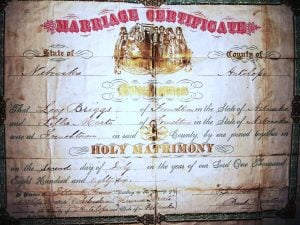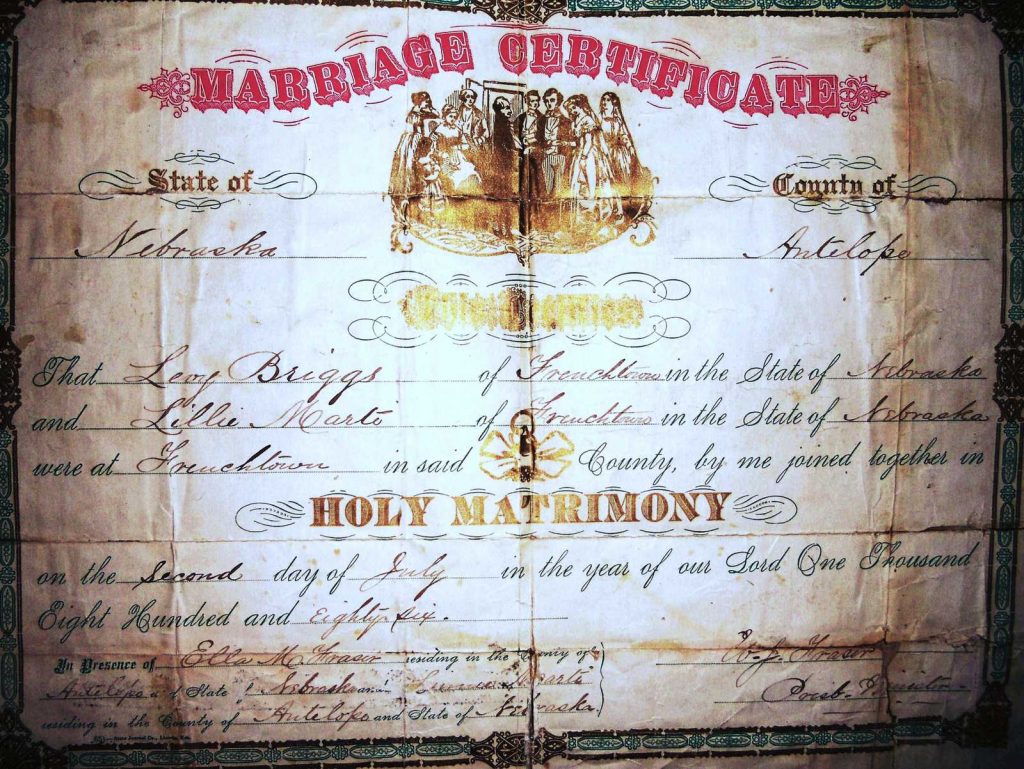Burnett
The town of Burnett is located on the line between Antelope and Madison Counties. The most of the town and the railroad station are in Antelope. The town was named in honor of Mr. Burnett, first Superintendent of the Sioux City & Pacific Railroad.
A. M. Burnham was the first settler, and opened the first store in March 1880. F. Dilts came here in October 1880, and William Childers, V. B. Lewis and James Childers in 1881. April 1, 1882, Burnett contained forty inhabitants. It is pleasantly situated in the Elkhorn Valley, a short distance south of the river, and is surrounded by a very fertile agricultural region.
The first schoolhouse in the vicinity of Burnett, in Antelope County, was built in 1880, about two miles to the west, Miss Anna Hussie being the first teacher. Previously, however, a schoolhouse had been built in Madison County, about one mile east of Burnett, in 1873, in which Mrs. Alice Livingston was the first teacher, in the same year. In Burnett and vicinity there are a number of church organizations — United Brethren, Baptist, Congregationalist, Methodist and Christian. The first sermon that was preached in the town of Burnett was by the Rev. Mr. Kidder, of Norfolk, in the depot building, very near the close of the year in 1879. The first Postmaster in Burnett was Charles Washburn, in 1880. There are now three general stores, two drug and one hardware store, one blacksmith shop and one hotel.
Clearwater
This town was named from the creek upon which it is located. The first settler was Robert Marwood, in 1870. Other settlers followed in the summer and fall of 1872, in the persons of S. P. Grow, N. A. De Camp, G. H. McGee, A. J. Wright, E. Stevens and Jacob Garbough.
The first child born was a daughter of Robert Marwood, in November, 1871; the first marriage, that of Calvin Stevens to Elvira Prosser, February 14, 1876, Rev. J. R. Wolfe officiating; the first death, that of a small child of James Choat, accidentally scalded to death in November, 1871. Charles Grow was killed by falling on a circular saw in McGee’s mill, April 27, 1874, and on May 1, immediately following, W. S. Metcalf died from the effects of being kicked by a horse about a week previously.
The first public school taught in Clearwater was in the summer of 1872, in a log schoolhouse, by Mrs. Susan De Camp. Rev. Keith, a Methodist minister, preached the first sermon in the fall of 1871. The post office was established in the spring of 1872, and named Antelope, with James H. Smith for Postmaster. The name of the post office was changed to Clearwater in 1880.
G. H. McGee’s sawmill was built in the spring of 1871, and the first store was opened by Dr. Tubbs in 1878.
The Clearwater Congregational Church was organized in 1873, by Rev. H. Griffiths.
Clear Spring
This post office is at the farmhouse of J. A. Douglas, and was established in 1880, with Mr. Douglas for first Postmaster. The first school was taught in this vicinity by S. S. Murphy, in the winter of 1880-81, and the first sermon was preached by Rev. Mr. Emmerson in 1879, at the house of J. Davenport.
Frenchtown

Frenchtown is situated in the western part of Antelope County, on rolling prairie, gently sloping toward the streams. Farther back, the land is somewhat hilly and devoid of timber, but along the streams some timber grows. The place was named Frenchtown on account of the predominance of French people among the early settlers. The first settlement was made here on August 9, 1869, by Louis Patras, Martin Freeman and Louis Contois. They were soon followed by Frank Patras, Andrew Thibault and James Grenier. The first child born in Frenchtown was Freddie Patras, in 1870; the first marriage, that of Joseph Lessard to Miss Emma Thibault, in January, 1875; and the first death, that of J. O. Grenier, by drowning.
The first school taught here was by Mrs. Buoy, in her own house, in the fall of 1870. A schoolhouse was built in 1871. A Catholic Church was built in the town in 1874. The post office was established in 1871, J. Saxton being appointed first Postmaster. A store was opened in 1874, by Charles W. Graham. The surrounding country is beautiful, well adapted to farming, and inhabited by a peaceful and contented people.
Glenalpine
This is a country post office, situated at the head of one of the branches of the Verdigris, hence its name. The first settler was Lucius Kibbee, in 1876. Other settlers came in 1878 — William Campbell, R. Hill, W. H. Silers and A. Miller. The first child born was Julia A. Silers, in 1879. The first marriage, that of S. R. Swetland to Maria Burck, in the fall of 1879; and the first death, that of Lucius Kibbee, the fall of 1880.
The first school taught at Glenalpine was by Rachael Burck, in the summer of 1880; and the first sermon was preached by Rev. Mr. Porter, at the residence of R. Hill, in the fall of 1879. The post office was established May 25, 1880, with William Campbell first Postmaster.
Glenalpine is located on rolling prairie, and is surrounded by a country well adapted to dairying and the raising of cattle and sheep. It is well watered by the tributaries of the Verdigris, and has numerous springs. The valleys are a rich, black sandy loam; table-lands, a clay loam, underlain with magnesia limestone. The settlers are mainly Scotch, English and Americans.
Jessup
Jessup is situated in the extreme northern part of the county, on the main branch of the Verdigris. The country is well watered by that river and its branches, and is well adapted to dairying and stock-raising. It was named in honor of ex-Gov. Jessup, of Iowa, and is situated about six miles northeast of Glenalpine.
Orchard
This post office is situated in the northwest part of the county. D. L. Cramer was the first settler. September 17, 1880. Soon afterward, J. M. Wadsworth, George Buffington and S. P. Cramer came into this vicinity. The first marriage was that of Frank Wood to _____ ____, August 1, 1881; and the first death, that of S. S. Cramer, January 25, 1882. During the winter of 1881-82, D. L. Cramer taught the first school at his own house, the schoolhouse not being completed; and at the same place, Rev. Mr. Pollox preached the first sermon January 22, 1882. The post office was established here July 1, 1881, S. P. Cramer first Postmaster; and it was named Orchard, because an orchard of apple trees had been set out in the immediate vicinity. The first store was opened by W. E. Cramer July 1, 1881. Orchard is surrounded by prairie, for the most part level, and a fine grazing country.
Royal
Royal Post Office is situated in the northern part of the county, near the source of the east branch of the Verdigris, which flows northward through Knox County into the Niobrara. The surrounding country is level prairie. It was named Royal after Royal Thayer. The country in this vicinity was settled in 1879, by C. H. Bligh, Henry Dailey, W. H. Couch, J. M. Bennet and Robert Smith — the first two arriving June 3, the others later in the year. The first birth here was that of Samuel Couch, son of W. H. And Mrs. Couch, July 14, 1879; the first marriage, that of Mr. and Mrs. Samuel Swetland, February 15, 1880; and the first death, that of Mrs. E. W. Allie, August 20, 1879. The first school taught was in the winter of 1881-82, by Jonas I. Houston, in a log house owned by Robert Smith. The first sermon was preached in the spring of 1882, at the residence of J. P. Anderson, by Rev. Mr. Brown. The post office was established in July, 1880, named Royal, and C. H. Bligh appointed Postmaster. At Royal was organized the first Farmers’ Alliance in the county, and it is today the strongest, containing forty members.
St. Clair
This post office was so named after George St. Clair, the first settler in the county, as elsewhere stated. It is pleasantly situated on the prairie, and surrounded by a fine farming country, the soil being adapted especially to corn and oats.
The first permanent settlers here were Sarah Fields, Orville Fields, Orson Fields, May 11, 1870; and Henry Eichkoff, July 1, 1870. S. P. Blankenship, Jonas P. Irish, Augustus and Charles A. Oelsligle and David Cossairt came in on March 20, 1871.
The first child born here was James Cossairt, in January, 1873, son of David and Mrs. Cossairt; the first marriage, that of Orville Fields to Miss Alice Bliss, February 1, 1874; and the first death, that of an infant child of Mr. and Mrs. Masters.
In the summer of 1873, Miss Alice Bliss taught the first school in St. Clair Valley, in a schoolhouse which had been built the preceding spring. A. D. Blankenship preached the first sermon, in 1872, at his residence.
The first post office was established in August, 1876, and named St. Clair, with E. M. Blackford for Postmaster, who has held the office ever since.
Willowdale
This post office is nicely situated at the head of Willow Creek, and is surrounded by a fine farming and stock-raising, gently rolling prairie.
The first settlers in this section were A. W. Waterman and John Jarmin, in March, 1874; John N. Storey and Andrew and Levi Minkler, in May; Lewis Bitney and Francis McEvony, in June; E. R. Andrews and Eli Bitney came in 1875. The post office was established in 1874, with A. W. Waterman for Postmaster. A store was opened in 1879, at the post office, by E. R. Andrews. The first school was taught by Mrs. A. W. Waterman in 1876. A sod schoolhouse was built here in the spring of 1879. It is a commodious building, still used as a temple of learning. A Congregational Church was organized in June, 1881, by Rev. Henry Griffiths, and a Presbyterian Church, July 17, 1881, by Rev. George Williams, with twenty members.
The first child born here was Myrtle A. Storey, daughter of Mr. and Mrs. John N. Storey, in November 1876. The first death was that of Mrs. McEvony, mother of Francis McEvony, in August, 1876. At Willowdale there is now only the post office and a blacksmith shop, the store having been moved to the railroad station at Plainview, Pierce County.
